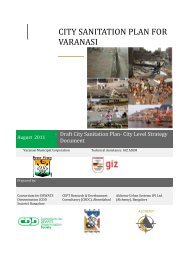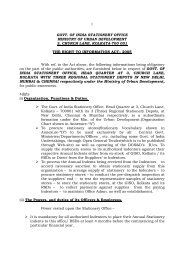CITY SANITATION PLAN - Ministry of Urban Development
CITY SANITATION PLAN - Ministry of Urban Development
CITY SANITATION PLAN - Ministry of Urban Development
Create successful ePaper yourself
Turn your PDF publications into a flip-book with our unique Google optimized e-Paper software.
Integrated Storm Water Drainage<br />
<strong>CITY</strong> <strong>SANITATION</strong> <strong>PLAN</strong> BAREILLY<br />
Integrated Storm Water Drainage system should be planned for the<br />
city.<br />
To accomplish this, local government and Nagar Nigam must change their current mindset. Many still<br />
view that water and sanitation investments are too costly and not sustainable or replicable. It is<br />
generally believed that some interventions are all that is possible. The Nagar Nigam does also disregard<br />
the squatter settlements which absorb much <strong>of</strong> growing urban population. Moreover the slum<br />
communities do not have ownership rights and are “not allowed” to invest in proper sanitary facilities,<br />
even if they have motivation and capacity.<br />
The first step is to provide basic sanitation or toilets facilities in slum and LIG. As mentioned earlier,<br />
these must ensure hygienic separation <strong>of</strong> excreta from human contact, which means feces must be<br />
confined until they are composted and safe. Regardless <strong>of</strong> the toilet technology selected, these systems<br />
must also address sanitation all the way “from toilet to river,” meaning that pathogens and pollutants<br />
cannot be allowed to enter nearby water sources, including aquifers. This is where sanitation becomes<br />
particularly challenging, as affordability and environmental cleanliness are <strong>of</strong>ten at odds. The simplest<br />
option; a pit latrine must be cleaned or emptied regularly, which is a difficult prospect in crowded<br />
areas. Pour-flush latrines require that an ample water supply is readily available, as well as properly-<br />
constructed septic tanks, drainage to carry away the wastewater, and services for eventually dealing<br />
with the collection <strong>of</strong> sludge and transfer to a septage treatment facility.<br />
Innovative partnerships must be forged to stimulate investments (PPP Model)<br />
To realize higher levels <strong>of</strong> service coverage and quality, sanitation programs must stimulate investments<br />
from as wide a range <strong>of</strong> sources as possible, including consumers themselves and the private sector.<br />
Successful public–private partnership (PPP) models can help overcome the limitations <strong>of</strong> local<br />
governments, which are under tremendous pressure in view <strong>of</strong> rapid urbanization and fast growing<br />
slum and low-income populations. In the sanitation sector, partnership arrangements between the<br />
public and private agencies, with the involvement <strong>of</strong> community networks, such as NGOs and CBOs,<br />
ADMINISTRATIVE STAFF COLLEGE OF INDIA, HYDERABAD Page 210
















